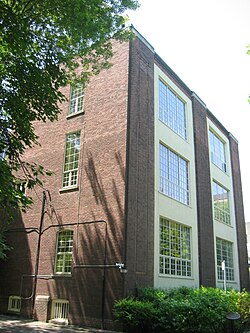Studio Building (Toronto)
This article needs additional citations for verification. (November 2009) |
| The Studio Building | |
|---|---|
 | |
| Location | 25 Severn Street Toronto, Ontario, Canada |
| Built | 1914 |
| Original use | Studios |
| Current use | Studios |
| Architect | Eden Smith |
| Designated | 2005 |
The Studio Building in Toronto, Ontario, Canada, was the home and working studio of several of the Group of Seven painters, their predecessors, and their artistic descendants, and is of enormous significance in the history of Canadian art. The building was designated a National Historic Site of Canada in 2005.[1][2] It was also designated by the City of Toronto under the Ontario Heritage Act through By-law 115-2003.[3]
Situated at 25 Severn Street, it is located in the Rosedale ravine immediately east of the above-ground Ellis portal that brings subway trains into and out of the north end of the
History
Financed by
The building was designed by
On his return from World War I, Jackson again took up residence, but this time on the top floor, in Studio 6. He removed Thomson's easel, made by Thomson's own hand, from the shed and used it for all the subsequent pictures he produced in the Studio Building. Shortly after he returned from wintering on Georgian Bay, he learned that in his absence he had been included in an informal group of Studio Building artists, exhibiting for the first time, called the Group of Seven. The resulting show had mixed results, but the Group was able to capitalize on the criticism they received; they were seen as vanguards of a new art style that was uniquely Canadian and challenging dated tastes.
By 1940, Harris was living in Vancouver, and his ties to the Studio Building, except emotional, were for all intents and purposes severed. In 1948, he sold the Studio Building to lawyer-turned-artist Gordon MacNamara and a partner for $20,000.

The Studio Building was well beyond its heyday. A.Y. Jackson, who by now was the only remaining member of the original tenants and even of the Group of Seven still living in the building,[5] said in his autobiography "A Painter's Country", that MacNamara slipped notes under the door of his studio complaining about the noise of his hammering while stretching canvases - MacNamara was a watercolourist working on paper - and mandating that Jackson would have to do his prep work in the basement. He left other notes, admonishing Jackson for walking about in his studio, insisting that he wear felt-soled shoes to muffle the noise. An unhappy Jackson left the building in 1955 with Lawren Harris mourning, in a letter from Vancouver:
Your moving from the Studio Building marks the end of an era, the one era of creative art that has the greatest significance for Canada... You were the real force and inspiration that led all of us into a modern conception that suited this country, and the last to leave the home base of operations.
It was only after lengthy negotiations with MacNamara that art collector Robert McMichael, in 1962, was able to purchase Tom Thomson's old shack and have it removed for exhibit at the McMichael gallery in Kleinberg, northwest of the city. MacNamara was concerned that locals, who were well aware of the shed's historic significance, might think him too eager to dispose of it. The terms, when finalized, stipulated that McMichael would pay MacNamara $800 and landscape the resulting vacant spot so as to remove any trace of the shed's presence.
MacNamara himself faced challenges near the end of his long life when the City of Toronto approved a proposal by Canadian Tire in 2003 to construct 18- and 25-storey condominium towers on the western side of the ravine. As the condominium buildings threatened to destroy the quality of light that artist tenants had enjoyed for nine decades, MacNamara appealed the approval to the Ontario Municipal Board. MacNamara eventually withdrew his appeals, and the condominium approvals came into full force and effect.[6] As a condition of his withdrawal, he received a $75,000 settlement from Canadian Tire.[citation needed]
Backed by endorsements from the
Gordon MacNamara died in 2006, leaving the future of the building in some question. His son has expressed interest in selling the building, appraised for $1.37 million. While its designation as an historic site protects only the outside of the building, many hope that a new owner will do as much as possible to protect its legacy as a Canadian art treasure.
References
- ^ The Studio Building, Directory of Designations of National Historic Significance of Canada
- ^ The Studio Building, National Register of Historic Places
- ^ 25 Severn Street, City of Toronto Inventory of Heritage Properties
- ^ ISBN 9781770704527.
- ISBN 9780919837379.
- ^ Nasmith, Catherine. "Studio Building-Post Script". Built Heritage News. Issue no. 39. 2004-09-03. Retrieved 2008-07-01.
Bibliography
- Jackson, A.Y.: A Painter's Country: The Autobiography of A.Y. Jackson, ISBN 0772011028
- Larsen, Wayne: A.Y. Jackson: A Love for the Land, XYZ Publishing; Lantzville, B.C., 2003. ISBN 1-894852-06-0
- McMichael, Robert: One Man's Obsession, Prentice-Hall Canada Inc.;Scarborough Ontario, 1986. ISBN 0-13-566944-8
External links
- Art News Canada, "Group of Seven's Legendary Studio Up for Grabs?"
- CBC News report about Gordon MacNamara's fight against Canadian Tire's condo development (includes video footage)

